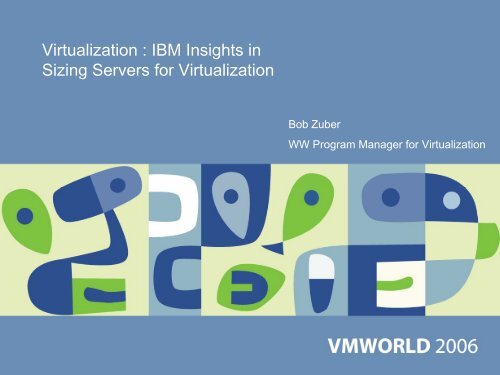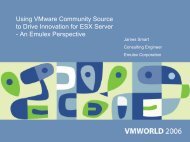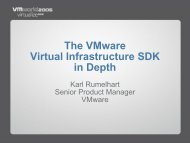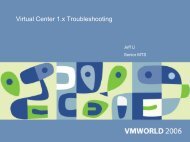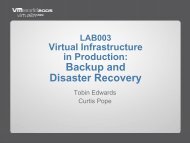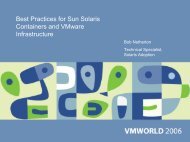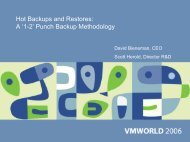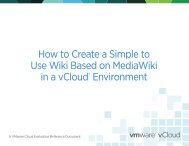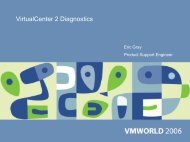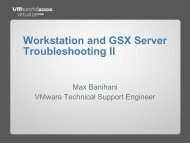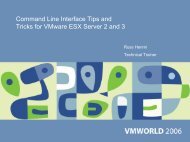Virtualization : IBM Insights in Sizing Servers for ... - VMware
Virtualization : IBM Insights in Sizing Servers for ... - VMware
Virtualization : IBM Insights in Sizing Servers for ... - VMware
You also want an ePaper? Increase the reach of your titles
YUMPU automatically turns print PDFs into web optimized ePapers that Google loves.
AgendaSiz<strong>in</strong>gThe elements of siz<strong>in</strong>g<strong>IBM</strong>’s <strong>in</strong>sights <strong>in</strong>to siz<strong>in</strong>g<strong>IBM</strong> PortfolioPortfolio Position<strong>in</strong>gCompetitive AdvantageSystems Management – <strong>IBM</strong> DirectorWhat is itHow it helps virtualizationSummary
Long-term Focus On <strong>Virtualization</strong> Across Our SystemsSystem z9zSeries ®System x BladeCenterSystem p5 iSeries <strong>IBM</strong> SystempSeries ® Storage OpenPower ®While virtualization sounds complex, it’s really a simple idea. <strong>IBM</strong> Systemscan provide virtualization capabilities that are unique <strong>in</strong> the marketplace.• <strong>IBM</strong> ma<strong>in</strong>frame virtualization – 40 year history of world-class <strong>in</strong>novation• <strong>IBM</strong> X-Architecture designed <strong>for</strong> virtualization, shared cross plat<strong>for</strong>m• CoolBlue - Power and Cool<strong>in</strong>g designs that lead the <strong>in</strong>dustry• <strong>Virtualization</strong> Management software that simplifies your environment• <strong>Virtualization</strong> features do not require “rip and replace” upgrades• <strong>VMware</strong>’s number one OEM vendor (1)Note (1) : Based on bundled license revenue
Why is Siz<strong>in</strong>g ImportantThere are so many siz<strong>in</strong>g considerations, either the source or targetConsider just the Source serverAverage and Peak CPU utilizationAverage and Peakmemory utilizationPage Size and pageextentsDisk I/O throughputNetwork I/O throughputAnd now the Target serverCPU UtilizationMemory UtilizationPage size page extentsDisk I/O throughput
Rules <strong>for</strong> <strong>Virtualization</strong>Hot spot avoidance – Reduce risk of multiple workloads saturat<strong>in</strong>ggiven physical serverIf the virtual servers are spread over multiple small servers (e.g., four 2-ways)rather than hosted by a large server (e.g, a s<strong>in</strong>gle 8-way x460) then surges <strong>in</strong>workload demand may saturate a given physical server while other physicalservers are underutilized. A larger shared server can avoid artificial hot spotswhich impact workload QoS (throughput and response time).Headroom <strong>for</strong> hard to predict workloadsIt is often the case <strong>in</strong> plann<strong>in</strong>g a new multi-system configuration that the resourceneeds of some systems/workloads are not known with confidence. In such cases,there is a big advantage <strong>in</strong> us<strong>in</strong>g a scalable server such as an x460 to hostmultiple virtual servers so that surprises <strong>in</strong> <strong>in</strong>dividual system/workload demand canbe handled without acquir<strong>in</strong>g additional server hardware or mak<strong>in</strong>g physicalchanges.Peak load ResponsivenessWith a large server rather than N smaller servers, there is a greater probability thata processor will be free at any po<strong>in</strong>t <strong>in</strong> time to handle spikes <strong>in</strong> any workloadsdemand.Source: J. Rymarczyk<strong>IBM</strong> Fellow, Chief <strong>Virtualization</strong> Technologist
Gather The Data<strong>VMware</strong> ® CapacityPlanner<strong>IBM</strong> CDATBoth gather <strong>in</strong>ventoryand per<strong>for</strong>mance<strong>in</strong><strong>for</strong>mation <strong>for</strong> serversand clients.Data is needed toprovide the best siz<strong>in</strong>g<strong>for</strong> your customersworkloads.Us<strong>in</strong>g <strong>Virtualization</strong> <strong>for</strong>Server Consolidation isonly as good as the<strong>in</strong>itial siz<strong>in</strong>g<strong>in</strong><strong>for</strong>mation.
Real-World Workload EnvironmentsNon-Steady State(Unpredictable)Steady State(Predictable)Non-Steady vs Steady State workloads1.Peak utilization should be exam<strong>in</strong>ed <strong>for</strong> all Non-Steady workloads. Email server peak periods may beentirely different from the CRM server, caus<strong>in</strong>g peaks and valleys to either negate each other, or doubl<strong>in</strong>gthe amount of resources needed.2.Average utilization can be exam<strong>in</strong>ed <strong>for</strong> Steady state workloads, once they have achieved steady state.Measurements can be per<strong>for</strong>med prior to Steady State, but this would not reflect the workloads trueresource needs.Source : Intel Technology Journal, Vol 10 Issue 3, published August 10, 2006 - “Redef<strong>in</strong><strong>in</strong>g ServerPer<strong>for</strong>mance Characterization <strong>for</strong> <strong>Virtualization</strong> Benchmark<strong>in</strong>g”
What is <strong>VMware</strong> ® Capacity Planner?Agent-less discovery,<strong>in</strong>ventory,and per<strong>for</strong>mance collectionData Sources: WMI, Registry &Perfmon API calls on W<strong>in</strong>dowsand Remote SSH Sessionsus<strong>in</strong>g UNIX and L<strong>in</strong>ux utilitiesHourly per<strong>for</strong>mancemetrics <strong>for</strong> days/weeksCDAT compatibleWeb-based report<strong>in</strong>gIndustry benchmark<strong>in</strong>g /comparisonConsolidation andvirtualizationscenario model<strong>in</strong>gIncorporated <strong>in</strong>to BCEand <strong>Virtualization</strong>Assessment reportsCreate Server GroupsSelect <strong>IBM</strong>Server ModelModel <strong>for</strong> <strong>VMware</strong>
What is CDAT? – Consolidation, Discovery & AnalysisDiscovers servers on the networkEstablishes communication with the servers on the network:SNMP <strong>for</strong> all serversexcept xSeriesStandard API calls <strong>for</strong>xSeriesTakes a snap shot ofthe data that iscollected and storedon the server by theOS and theper<strong>for</strong>mance countersExports the data <strong>in</strong>toExcel spread sheetwhich can beexported to anyspread sheet of yourchoiceServergrouped<strong>in</strong>tocategoriesby CDAT<strong>for</strong> datacollectionpurposesThe contents ofthe SQL servergroup – selecteda group, server,server<strong>in</strong><strong>for</strong>mation
Customer Consolidation StudyMethodology <strong>for</strong> the <strong>Virtualization</strong> Siz<strong>in</strong>g GuideUsed customer survey data to def<strong>in</strong>e key workload classifications targeted <strong>for</strong>server consolidationAnalyzed recent CDAT (1) studies <strong>for</strong> 30 customers• Organized their legacy servers by application type <strong>in</strong>to the key workloadclassifications• Entered more than 3,200 servers <strong>in</strong> the customer study database• Def<strong>in</strong>ed typical average and peak utilization statistics <strong>for</strong> each key workloadclassificationInput typical workloads from each workload classification <strong>in</strong>to <strong>IBM</strong>’s VISIAN (2) tool• VISIAN consolidated the workloads <strong>in</strong>to virtual mach<strong>in</strong>es onto a target serveraccord<strong>in</strong>g to the Headroom Rules.• VISIAN def<strong>in</strong>ed the limit<strong>in</strong>g factor <strong>for</strong> add<strong>in</strong>g additional workloads (CPU,Memory, Virtual CPU)Notes :1. <strong>IBM</strong>’s CDAT is a stand-alone discovery tool that automatically gathers a significant amount of server <strong>in</strong>ventory, configuration and per<strong>for</strong>mance data, generat<strong>in</strong>gan enterprise-wide view of server population and usage. <strong>IBM</strong> has per<strong>for</strong>med over 2,000 customer server consolidation studies <strong>in</strong>volv<strong>in</strong>g over 200,000 servers.2. <strong>IBM</strong>’s VISIAN is a tool that facilitates the calculation of the optimal number of mach<strong>in</strong>es that can be consolidated onto an <strong>IBM</strong> System x server runn<strong>in</strong>g <strong>VMware</strong>ESX Server 2.5. VISIAN is an <strong>in</strong>ternal-use-only tool, and an patent is pend<strong>in</strong>g.
<strong>Virtualization</strong> Siz<strong>in</strong>g <strong>Insights</strong>Server HeadroomSoftware Per<strong>for</strong>mance VariationCustomer consolidation studies highlight a greater variation between average CPU utilization and peak CPU utilization on legacy 2-Psource workloads than on 4-P and 8-P source workloads.Variations <strong>in</strong> the CPU utilization will determ<strong>in</strong>e the number of virtual mach<strong>in</strong>es possible on a server configuration.Server HeadroomPeak and Average UtilizationSize <strong>for</strong> excess capacity to ensure that workloads have headroom <strong>for</strong> peak periods of operation when they require greater serverresources than their average or steady state period of operation.To calculate the correct amount of headroom, consider the variation between average and peak server resource requirements <strong>for</strong>each consolidated workload.Scheduler ContentionThe Headroom Rules account <strong>for</strong> this variation.Peak Utilization versus Average UtilizationTo correctly size the number of virtual mach<strong>in</strong>es per plat<strong>for</strong>m, consider the average and peak utilization of the processor, memory,and disk.The chart on the next page shows the recommended number of VMs based on both the peak and average utilizations. The firstlettered <strong>in</strong>dicator aligns with the number of recommended VMs based on the peak utilization values. The second lettered <strong>in</strong>dicatoraligns with the number of recommended VMs based on the average utilization values.The letter represents the constra<strong>in</strong><strong>in</strong>g factor which is the resource on the server that limits the recommended number of VMs <strong>for</strong> thatserver configuration.Memory versus CPU constra<strong>in</strong>tsPhysical CPU utilization is not always the primary constra<strong>in</strong>t <strong>for</strong> consolidated workloads.Workloads that are consolidated based on peak utilizations tend to be CPU-constra<strong>in</strong>ed and those based on average utilizationstend to be memory-constra<strong>in</strong>ed or vCPU-constra<strong>in</strong>ed.<strong>VMware</strong> Scheduler ContentionThe amount of work that can be scheduled has a non-l<strong>in</strong>ear relationship to the number of CPUs and the number of vCPUS def<strong>in</strong>ed<strong>for</strong> a given virtual mach<strong>in</strong>e.VMs with more than 1 vCPU have lower scheduler latency on SMP servers with more CPU cores compared to servers with lessCPU cores.
Server Headroom CalculationData collected from 3,000 servers viaCDAT consolidation studiesW<strong>in</strong>dows and L<strong>in</strong>ux non-virtualized environmentsAverage seven different application workloadsLarger servers with more resources are lessvolatile2005 & 2006 studies adds another 12K serversto our dataVISIAN consolidated the workloads <strong>in</strong>to virtualmach<strong>in</strong>es onto a target server.VISIAN def<strong>in</strong>ed the limit<strong>in</strong>g factor <strong>for</strong> add<strong>in</strong>gadditional workloads (CPU, Memory, VirtualCPU)ServerAvg CPUUtilizationPeak CPUUtilization2-P 44% 7% 53% 90%4-P 60% 5%35% 90%ServerHeadroom37%55%8-P 68% 3% 25% 90% 65%<strong>Virtualization</strong> <strong>in</strong>creases server utilization, but proper configuration mustallow <strong>for</strong> application usage spikes2-P Add 37% headroom to 7% average to achieve 44% avg and 90% peak virtual capacity4-P Add 55% headroom to 5% average to achieve 60% avg and 90% peak virtual capacity8-P Add 65% to 3% average to achieve 68% avg and 90% peak virtual capacityRule of thumb <strong>for</strong> virtualized System x <strong>Servers</strong>:2P = 44% 4P = 60% 8P = 68%NOTE : The <strong>in</strong><strong>for</strong>mation <strong>in</strong> the follow<strong>in</strong>g table represents the conclusions of <strong>IBM</strong> from test<strong>in</strong>g of systems <strong>in</strong> a controlledenvironment. Actual environmental costs and per<strong>for</strong>mance characteristics will vary depend<strong>in</strong>g on <strong>in</strong>dividual customerconfigurations and conditions. <strong>IBM</strong> makes no representation or warranty that an <strong>in</strong>dividual user will achieve resultsequivalent to the levels stated <strong>in</strong> this document.Virtualized Legacy 2-P Workloads Source Workloads
x86 Server Utilization ObservationsThe CDAT <strong>in</strong><strong>for</strong>mation wasbroken <strong>in</strong>to two types ofworkloads, 2-P and 4-P.The siz<strong>in</strong>g was based onboth the average and peak<strong>for</strong> CPU, memory, disk, andnetwork I/O.The disk and network I/Owas not <strong>in</strong>cluded <strong>in</strong> thepr<strong>in</strong>t document, it was nota constra<strong>in</strong>t that was seen<strong>in</strong> the siz<strong>in</strong>g table.This <strong>in</strong><strong>for</strong>mation was used tosize the target servers.Each cell of the siz<strong>in</strong>gguide is represented bythese 6 workloads, andadded <strong>in</strong> a round rob<strong>in</strong>fashion to achieve theneeded workloads.Legacy 2-PWorkloadsConsolidation Parameters <strong>for</strong> Source WorkloadsTypicalProcessorAvg CPUUtilizationPeak CPUUtilizationAvgMemoryUsedPeakMemoryUsedInfrastructure Xeon 2.0GHz 8% 48% 568 768Web Xeon 1.8GHz 5% 47% 592 768Application Xeon 1.8GHz 8% 52% 611 768Database Xeon 1.8GHz 9% 60% 1,199 1,536Term<strong>in</strong>al Server PIII 1.4GHz 9% 70% 603 1,024Email Xeon 2.0GHz 6% 50% 994 1,280Legacy 4-PWorkloadsTypicalProcessorAvg CPUUtilizationPeak CPUUtilizationAvgMemoryUsedPeakMemoryUsedInfrastructure Xeon MP 2.5GHz 6% 35% 841 1,024Web Xeon MP 2.5GHz 4% 24% 737 1,024Application Xeon MP 2.7GHz 4% 34% 935 1,280Database Xeon MP 2.5GHz 5% 37% 1,553 1,792Term<strong>in</strong>al Server Xeon MP 2.7GHz 6% 45% 882 1,536Email Xeon MP 2.8GHz 4% 34% 1,295 1,536Table C - Consolidation Parameters <strong>for</strong> Source WorkloadsNOTE : The <strong>in</strong><strong>for</strong>mation <strong>in</strong> the follow<strong>in</strong>g table represents the conclusions of <strong>IBM</strong> from test<strong>in</strong>g of systems <strong>in</strong> a controlledenvironment. Actual environmental costs and per<strong>for</strong>mance characteristics will vary depend<strong>in</strong>g on <strong>in</strong>dividual customerconfigurations and conditions. <strong>IBM</strong> makes no representation or warranty that an <strong>in</strong>dividual user will achieve resultsequivalent to the levels stated <strong>in</strong> this document.
<strong>Virtualization</strong> Siz<strong>in</strong>g GuidanceLegacy 2-P Workloads virtualized to a VM def<strong>in</strong>ed as a S<strong>in</strong>gle processor (1vCPU)Number of Recommended VMsS<strong>in</strong>gle Core - # of VMs 1 2 3 4 5 6 7 8 9 10 11 12 13 14 15 16 17 18 19 20 21 22 23 24 25 26 27 28 29 30 31 32 33 34 35 36 37 38 39 40 41 42 43 44 45 46 47 48 49 50 51 52 53 54 55 56 57 58 59 60 61 62 63 64 65 66 67 68 69 70x346/2DP 3.8GHz 8 GB C M Legendx346/2DP 3.8GHz 16 GB C M VMs runn<strong>in</strong>g at Peak Utilizationx366/4MP 3.66GHz 16 GB C M VMs runn<strong>in</strong>g at Avg Utilizationx366/4MP 3.66GHz 32 GB C M C CPU Constra<strong>in</strong>tx366/4MP 3.66GHz 40 GB C V M Memory Constra<strong>in</strong>tx460/8MP 3.33GHz 32 GB C M V vCPU Constra<strong>in</strong>tx460/8MP 3.33GHz 64 GB C MDual Core - # of VMs 1 2 3 4 5 6 7 8 9 10 11 12 13 14 15 16 17 18 19 20 21 22 23 24 25 26 27 28 29 30 31 32 33 34 35 36 37 38 39 40 41 42 43 44 45 46 47 48 49 50 51 52 53 54 55 56 57 58 59 60 61 62 63 64 65 66 67 68 69 70x3650/2DP 3.0GHz 8 GB C Mx3650/2DP 3.0GHz 16 GB C M Best Estimate at this timex3850/4MP 3.0GHz 16 GB C Mx3850/4MP 3.0GHz 32 GB C Mx3850/4MP 3.0Ghz 48 GB C Mx3950/8MP 3.0GHz 32 GB C Mx3950/8MP 3.0GHz 64 GB C MLegacy 4-P Workloads virtualized to a VM def<strong>in</strong>ed as a Dual processor (2vCPU)Number of Recommended VMsS<strong>in</strong>gle Core - # of VMs 1 2 3 4 5 6 7 8 9 10 11 12 13 14 15 16 17 18 19 20 21 22 23 24 25 26 27 28 29 30 31 32 33 34 35 36 37 38 39 40 41 42 43 44 45 46 47 48 49 50 51 52 53 54 55 56 57 58 59 60 61 62 63 64 65 66 67 68 69 70x346/2DP 3.8GHz 8 GB C Mx346/2DP 3.8GHz 16 GB CVx366/4MP 3.66GHz 16 GB C Mx366/4MP 3.66GHz 32 GB C Vx366/4MP 3.66GHz 40 GB C Vx460/8MP 3.33GHz 32 GB C Mx460/8MP 3.33GHz 64 GB C VDual Core - # of VMs 1 2 3 4 5 6 7 8 9 10 11 12 13 14 15 16 17 18 19 20 21 22 23 24 25 26 27 28 29 30 31 32 33 34 35 36 37 38 39 40 41 42 43 44 45 46 47 48 49 50 51 52 53 54 55 56 57 58 59 60 61 62 63 64 65 66 67 68 69 70x3650/2DP 3.0GHz 8 GBx3650/2DP 3.0GHz 16 GBx3850/4MP 3.0GHz 16 GB C Mx3850/4MP 3.0GHz 32 GB C Mx3850/4MP 3.0Ghz 48 GB C Cx3950/8MP 3.0GHz 32 GB C Mx3950/8MP 3.0GHz 64 GB C VTable A - <strong>Virtualization</strong> Siz<strong>in</strong>g GuidanceNOTE : The <strong>in</strong><strong>for</strong>mation <strong>in</strong> the follow<strong>in</strong>g table represents the conclusions of <strong>IBM</strong> from test<strong>in</strong>g of systems <strong>in</strong> a controlledenvironment. Actual environmental costs and per<strong>for</strong>mance characteristics will vary depend<strong>in</strong>g on <strong>in</strong>dividual customerconfigurations and conditions. <strong>IBM</strong> makes no representation or warranty that an <strong>in</strong>dividual user will achieve resultsequivalent to the levels stated <strong>in</strong> this document.
Selection CriteriaLegacy 2-P Workloads virtualized to a VM def<strong>in</strong>ed as a S<strong>in</strong>gle processor (1vCPU)Dual Core - # of VMs 1 2 3 4 5 6 7 8 9 10 11 12 13 14 15 16 17 18 19 20 21 22 23 24 25 26 27 28 29 30 31 32 33 34 35 36 37 38 39 40 41 42 43 44 45 46 47 48 49 50x3650/2DP 3.0GHz 8 GB C Mx3650/2DP 3.0GHz 16 GB C M Best Estimate at this timex3850/4MP 3.0GHz 16 GB C Mx3850/4MP 3.0GHz 32 GB C Mx3850/4MP 3.0Ghz 48 GB C Mx3950/8MP 3.0GHz 32 GB C Mx3950/8MP 3.0GHz 64 GBCZone 1 (Conservative)Aggressive application (ie. Database)Unpredictable workloadNo tolerance <strong>for</strong> per<strong>for</strong>mance degradationZone 2 (Moderate)Moderately aggressive application (ie. Collaboration)Predictable workloadSome tolerance <strong>for</strong> per<strong>for</strong>mance degradation2-P 4-P 8-PZone 1 (VMs/Memory) 3 / 8GB 9 / 16GB 16 / 24GBZone 2 6 / 8GB 18 / 24GB 32 / 40GBZone 3 9 / 16GB 27 / 32GB 48 / 52GBZone 3 (Aggressive)Lightly aggressive application (ie. Web)Predictable WorkloadNOTE : The <strong>in</strong><strong>for</strong>mation <strong>in</strong> the follow<strong>in</strong>g table represents the conclusions of <strong>IBM</strong> from test<strong>in</strong>g of systems <strong>in</strong> a controlledenvironment. Actual environmental costs and per<strong>for</strong>mance characteristics will vary depend<strong>in</strong>g on <strong>in</strong>dividual customerconfigurations and conditions. <strong>IBM</strong> makes no representation or warranty that an <strong>in</strong>dividual user will achieve resultsequivalent to the levels stated <strong>in</strong> this document.High tolerance <strong>for</strong> per<strong>for</strong>mance degradation
<strong>Virtualization</strong> Siz<strong>in</strong>g <strong>Insights</strong>Server HeadroomPeak and Average UtilizationScheduler Contention
Guidance from <strong>VMware</strong> ®The Benefits of CPU Dense ESX Server Hosts:“The chance that the scheduler can f<strong>in</strong>d room <strong>for</strong> a particularworkload without much reshuffl<strong>in</strong>g of virtual mach<strong>in</strong>es will always bebetter when the scheduler has more CPUs across which it can search<strong>for</strong> idle time. For this reason, it will generally be better to purchase twofour-way ESX Server licenses than to purchase four two-waymach<strong>in</strong>es. Similarly, two eight-way servers will provide moreschedul<strong>in</strong>g flexibility than four four-way servers.”Tips and Techniques <strong>for</strong> Implement<strong>in</strong>g InfrastructureServices on ESX Server
<strong>VMware</strong> ® SchedulerS<strong>in</strong>gle Core 2-PCPU 1 CPU 2First Clock CycleSecond Clock CycleThird Clock Cycle1 vcpu, 100%2 vcpu, 200%2 vcpu, 150%1 vcpu, 50%LatencyFourth Clock Cycle1 vcpu, 100%4 vcpu, 400%
<strong>VMware</strong> ® SchedulerDual Core 2-P&S<strong>in</strong>gle Core 4-P1 vcpu, 100%CPU 1 CPU 2 CPU 3 CPU 4First Clock Cycle2 vcpu, 200%2 vcpu, 150%1 vcpu, 50%LatencySecond Clock Cycle1 vcpu, 100%4 vcpu, 400%Third Clock Cycle
<strong>VMware</strong> ® SchedulerDual Core 4-PCPU 1 CPU 2 CPU 3 CPU 4 CPU 5 CPU 6 CPU 7 CPU 81 vcpu, 100%2 vcpu, 200%2 vcpu, 150%1 vcpu, 50%LatencyFirst Clock Cycle1 vcpu, 100%4 vcpu, 400%Second Clock Cycle
AgendaSiz<strong>in</strong>gThe elements of siz<strong>in</strong>g<strong>IBM</strong>’s <strong>in</strong>sights <strong>in</strong>to siz<strong>in</strong>g<strong>IBM</strong> PortfolioPortfolio Position<strong>in</strong>gCompetitive AdvantageSystems Management – <strong>IBM</strong> DirectorWhat is itHow it helps virtualizationSummary
x86 <strong>Servers</strong> Made Better With <strong>Virtualization</strong>InfrastructureApplication serv<strong>in</strong>gsimplificationPlat<strong>for</strong>m <strong>IBM</strong> BladeCenter ® <strong>IBM</strong> System x TMTwo-processor rack & towerDescriptionIntegrat<strong>in</strong>g server, network<strong>in</strong>gComb<strong>in</strong><strong>in</strong>g a few applicationsand storage resourceson a s<strong>in</strong>gle server <strong>for</strong> greaterutilizationServer consolidation<strong>IBM</strong> <strong>IBM</strong> System System x Four x TM + Four processor +processor rack rackConsolidat<strong>in</strong>g large numbers ofunderutilized servers <strong>for</strong>greatest TCOKey attributesHardware usabilityPackag<strong>in</strong>g densityUnified managementPower/cool<strong>in</strong>g sav<strong>in</strong>gsServer mobilityHigh availability/disasterrecovery capabilityIndustry-standard designPrice/per<strong>for</strong>manceCompatibilityMultiple apps per serverHigh utilizationPer<strong>for</strong>manceScalabilityStrong reliability featuresApplication isolationReduction of physical systemsRapid system deploymentIntegrationUtilizationReduction
<strong>IBM</strong> differentiates itself from the competitionBladeCenter ®•Compatibility across chassis•Comprehensive ecosystem•Power management•Two redundant high-speedfabricsSystem xtwo-processor rack& tower•Innovative design withstandard parts•More memory DIMMS perprocessor than competitors•More I/O slots perprocessor than competitorsCommon across the portfolioSystem xfour + processor rack•<strong>IBM</strong> X3 chipset•Up to 32-socket scalability•Ma<strong>in</strong>frame-<strong>in</strong>spired reliability•PFA on more componentsthan competitors•<strong>IBM</strong> CoolBlue <strong>in</strong>novations•<strong>IBM</strong> Director•Largest OEM vendor (1)•<strong>IBM</strong> <strong>Virtualization</strong> ManagerNote (1) : Based on bundled license revenue
<strong>IBM</strong> and <strong>VMware</strong> ® : A Relationship Of Firsts!First <strong>VMware</strong> ® system vendorFirst jo<strong>in</strong>t development partnerFirst to leverage <strong>VMware</strong> ® SDKFirst to offer comprehensive supportMicrosoft W<strong>in</strong>dows, L<strong>in</strong>ux and <strong>IBM</strong> software<strong>in</strong> a <strong>VMware</strong> virtual mach<strong>in</strong>eFirst blade offer<strong>in</strong>g to <strong>in</strong>clude <strong>VMware</strong> ®First to <strong>in</strong>tegrate <strong>VMware</strong> ® <strong>in</strong>to a Virtual ClientSolutionFirst system vendor to announce <strong>VMware</strong> ®Infrastructure 3
BladeCenter ® Competitive AdvantageBladeCenter ®• Up to 30% better power efficiency• Fully redundant configurations <strong>for</strong> higher availability• Largest ecosystem provides more flexibility and choice• Innovative ‘snap-<strong>in</strong>’ scalable blade server that scales from 2P to 4P <strong>in</strong> seconds• Open architecture allows 3 rd party hw and sw vendors to provide more BladeCenter ® solutions• Blade compatibility across chassis provides <strong>in</strong>vestment protectionCommon across the portfolio•<strong>IBM</strong> CoolBlue <strong>in</strong>novations•<strong>IBM</strong> Director•Largest OEM vendor (1)•<strong>IBM</strong> <strong>Virtualization</strong> ManagerNote (1) : Based on bundled license revenue
When do I deploy <strong>IBM</strong> BladeCenter ® Systems?When you want to:Consolidate <strong>in</strong>frastructure and centralize managementReduce the complexity of ‘scale out’Reduce power consumptionMake more efficient use of datacenter spaceReduce floor space consumedReduce weightAchieve maximum processor densityIt’s that Simple ….. With <strong>IBM</strong>
I/O <strong>Virtualization</strong> SolutionBuild<strong>in</strong>g BlocksNetwork-embedded Inf<strong>in</strong>iBandSubnet ManagerHost channel adapter (HCA)With upper layer protocols• MPI• IPoIB• SDP• SRPL<strong>in</strong>ux, W<strong>in</strong>dows, and Solarisdriver supportCisco ® VFrame Server<strong>Virtualization</strong> SoftwareCisco Inf<strong>in</strong>iBandSwitch Module <strong>for</strong><strong>IBM</strong> BladeCenterEmbedded system andfabric managementCisco SFS 3012• Inf<strong>in</strong>iBand Switch<strong>in</strong>g• Inf<strong>in</strong>iBand to Ethernet• Inf<strong>in</strong>iBand to Fibre Channel
Infrastructure Simplification BenefitBe<strong>for</strong>e <strong>Virtualization</strong> ….14 x 2P Blades14 x 2P Blade56 ApplicationsAfter <strong>Virtualization</strong> ….Bladecenter ® chassis = $21.9KHS20 Blade 3.8GHz w/4GBBlade cost = $5.6K x 14 = $78.4KW<strong>in</strong>dows SE cost = $800 x 14 =$11.2KAverage CPU Utilization 8%Space Consumption = 7UPower Consumption = 2000W x 2 =4000WTotal Cost ~ $111.5KCost/Application ~ $7,964<strong>Virtualization</strong> could provide upto a ~ 2.25x cost improvement.Bladecenter ® chassis = $21.9KHS20 Blade 3.8Ghz w/4GBBlade cost = $5.6K x 14 = $78.4KW<strong>in</strong>dows SE cost = $800 x 56 = $44.8K<strong>VMware</strong> ® cost = $3,750 x 14 = $52.5KSupports 4 avg and 2 peak utilization VMs (1)Recommend 4 VMs/system (Zone 2)84 ApplicationsSpace Consumption = 7UPower Consumption = 2000W x 2 = 4000WTotal Cost ~ $197.6KCost/Application ~ $3,528Note (1) : Configuration per<strong>for</strong>med after publication of Siz<strong>in</strong>g Guide, 4 avg vs 2 peak <strong>for</strong> 4GB configuration.Web list prices found on www.ibm.com as of 8/1/06
BladeCenter ® Competitive AdvantageDual core AMD OpteronProcessorsDIMMs/Max RAMHP BL465c LS21 LS41 scalableblade2 2 48 DIMMs16GB8 DIMMs32GB16 DIMMs64MBHDDs 2 1(4)* 2(5)*I/O expansion slots 2 2 3High speed (10Gb) support In future now nowNote : Specifications <strong>for</strong> the server hardware can be found on the follow<strong>in</strong>g web sites : www.ibm.com,www.dell.com, and www.hp.com* With optional SIO expansion blade
<strong>IBM</strong> differentiates itself from the competitionSystem xtwo-processor rack& tower•Innovative design withstandard parts•More memory DIMMS perprocessor than competitors•More I/O slots perprocessor than competitorsCommon across the portfolio•<strong>IBM</strong> CoolBlue <strong>in</strong>novations•<strong>IBM</strong> Director•Largest OEM vendor (1)•<strong>IBM</strong> <strong>Virtualization</strong> ManagerNote (1) : Based on bundled license revenue
When do I deploy <strong>IBM</strong> Two Socket Systems?When you want to:Optimize highly demand<strong>in</strong>g bus<strong>in</strong>ess applicationsRun applications that require high-speed memory subsystemsNeed broad and low-latency I/O choices <strong>for</strong> Ethernet and fibrechannelActively manage energy consumptionConsolidate legacy 2 Socket servers us<strong>in</strong>g virtualization• When consolidat<strong>in</strong>g several traditional 2 way workloads• When consolidat<strong>in</strong>g less than 18 traditional 2 way workloadsIt’s that Simple ….. With <strong>IBM</strong>
Application Serv<strong>in</strong>g BenefitBe<strong>for</strong>e <strong>Virtualization</strong> ….6 x 2P Server2P ServerAfter <strong>Virtualization</strong> ….x3650 3.0GHz DC w/4GBServer cost = $4.9K x 6 = $29.4KW<strong>in</strong>dows SE cost = $800 x 6 = $4.8KAverage CPU Utilization 8%Space Consumption = 12UPower Consumption = 242Wx6 = 1452WTotal Cost ~ $34.2KCost/Application ~ $5,700x3650 3.0GHz DC w/8GBServer cost = $9.5KW<strong>in</strong>dows SE cost = $800 x 6 = $4.8K<strong>VMware</strong> ® cost = $3,750 x 2 = $7.5KSupports 8 avg and 3 peak utilization VMsRecommend 6 VMs/system (Zone 2)Space Consumption = 2UPower Consumption = 242WTotal Cost ~ $21.8KCost/Application ~ $3,633<strong>Virtualization</strong> could provide up to a ~ 1.5x cost improvement.Web list prices found on www.ibm.com as of 8/1/06
How about 12 legacy 2 way workloadsBe<strong>for</strong>e <strong>Virtualization</strong> ….12 <strong>Servers</strong>After <strong>Virtualization</strong> ….2P <strong>Servers</strong>Serv<strong>in</strong>g from….4P Serverx3650 3.0GHz DC w/8GBServer cost = $9.5K x 2 = $19KW<strong>in</strong>dows DC cost = $2K x 2 x 2 = $8K*<strong>VMware</strong> ® cost = $3,750 x 2 x 2 = $15KSupports 8 avg and 3 peak utilization VMsRecommend 6 VMs/System (Zone 2)Space Consumption = 18UPower Consumption = 246Wx2 = 492WTotal Cost ~ $42KCost/VM ~ $3,500x3850 3.0GHz DC w/24GBServer cost = $24.4K = $24.4kW<strong>in</strong>dows DC cost = $2K x 4 = $8K*<strong>VMware</strong> ® cost = $3,750 x 4 = $15KSupports 24 avg and 9 peak utilization VMsRecommend 18 VMs/system (Zone 2)Space Consumption = 3UPower Consumption = 799WTotal Cost ~ $47.4KCost/VM ~ $3,950Cost per VM could be up to 22% less on the 2P Plat<strong>for</strong>mNote : MS W<strong>in</strong>dows Datacenter licens<strong>in</strong>g – Estimated $2,000 processor, unlimited virtualization client. GA 9/28/06.Web list prices found on www.ibm.com as of 8/1/06
<strong>IBM</strong> 2 Socket Competitive AdvantageDual core AMD OpteronProcessorsDell HP DL385 G2 <strong>IBM</strong> x3655? 2 2DIMMs/Max RAM ? 8 DIMMs32GB16 DIMMs64MBHDDs ? 2(8)* 2(8)*I/O expansion slots ? 4 4High speed (10Gb) support ? now nowDell has NO ma<strong>in</strong>stream 2U twosocketAMD offer<strong>in</strong>g!!Note : Specifications <strong>for</strong> the server hardware can be found on the follow<strong>in</strong>g web sites : www.ibm.com,www.dell.com, and www.hp.com
<strong>IBM</strong> differentiates itself from the competitionCommon across the portfolioSystem xfour + processor rack•<strong>IBM</strong> X3 chipset•Up to 32-socket scalability•Ma<strong>in</strong>frame-<strong>in</strong>spired reliability•PFA on more componentsthan competitors•<strong>IBM</strong> CoolBlue <strong>in</strong>novations•<strong>IBM</strong> Director•Largest OEM vendor (1)•<strong>IBM</strong> <strong>Virtualization</strong> ManagerNote (1) : Based on bundled license revenue
When do I deploy <strong>IBM</strong> Scaleable Systems?When you want to:Run Applications that Multi-Thread• SAP, SAS, DB2, Oracle, SQL, CognosRun Applications that have large local storage requirements• Database, Large Collaboration and or Messag<strong>in</strong>gConsolidate legacy servers us<strong>in</strong>g virtualization• When consolidat<strong>in</strong>g more than 18 traditional 2 way workloads• When consolidat<strong>in</strong>g more than 10 traditional 4 way workloads• When partitions needs 2 or more virtual CPU’sIt’s that Simple ….. With <strong>IBM</strong>
Datacenter Consolidation BenefitBe<strong>for</strong>e <strong>Virtualization</strong> ….18 <strong>Servers</strong>After <strong>Virtualization</strong> ….4P Serverx3650 3.0GHz DC w/4GBServer cost = $4.9K x 18 = $88.2KW<strong>in</strong>dows SE cost = $800 x 18 = $14.4KAverage Utilization 5%Peak Utilization 47%Space Consumption = 36U = 1 RackPower Consumption = 242W x 18 = 4356WTotal Cost ~ $102.6KCost/Application ~ $5,700x3850 3.0GHz DC w/24GBServer cost = $24.4KW<strong>in</strong>dows DC cost = $2K x 4 = $8K*<strong>VMware</strong> ® cost = $3,750 x 4 = $15KSupports 24 avg and 9 peak utilizationVMsRecommend 18 VMs/system (Zone 2)Space Consumption = 3UPower Consumption = 835WTotal Cost ~ $47.4KCost/Application ~ $2,633<strong>Virtualization</strong> could provide up to a 2.2x cost improvementNote : MS W<strong>in</strong>dows Datacenter licens<strong>in</strong>g – Estimated $2,000 processor, unlimited virtualization client. GA 9/28/06.Web list prices found on www.ibm.com as of 8/1/06
How about 36 legacy 2 way workloads36 <strong>Servers</strong>Be<strong>for</strong>e <strong>Virtualization</strong> ….After <strong>Virtualization</strong> ….Consolidated to ….2P <strong>Servers</strong>4P Serverx3650 3.0GHz DC w/8GBServer cost = $9.5K x 6 = $57KW<strong>in</strong>dows DC cost = $2K x 2 x 6 = $24K*<strong>VMware</strong> ® cost = $3,750 x 2 x 6 = $45KSupports 8 avg and 3 peak utilization VMsRecommend 6 VMs/System (Zone 2)Space Consumption = 18UPower Consumption = 246Wx6 = 1476WTotal Cost ~ $126KCost/VM ~ $3,500x3850 3.0GHz DC w/24GBServer cost = $24.4K x 2 = $48.8kW<strong>in</strong>dows DC cost = $2K x 4 x 2 = $16K*<strong>VMware</strong> ® cost = $3,750 x 4 x 2 = $30KSupports 24 avg and 9 peak utilization VMsRecommend 18 VMs/system (Zone 2)Space Consumption = 6UPower Consumption = 799Wx2 = 1598WTotal Cost ~ $94.8KCost/VM ~ $2,633Cost per VM could be up to 25% less on the 4P Plat<strong>for</strong>mPlus Lower Software & Management CostsNote : MS W<strong>in</strong>dows Datacenter licens<strong>in</strong>g – Estimated $2,000 processor, unlimited virtualization client. GA 9/28/06.Web list prices found on www.ibm.com as of 8/1/06
X Architecture Competitive AdvantageDell 6950 HP DL585 <strong>IBM</strong> x3755Dual core AMD OpteronProcessorsDIMMs/Max RAM4 4 416 DIMMs 32 DIMMs 32 DIMMs64GB64GB128MBHDDs 4 X 3.5” SAS 8 x 2.5” SAS 5 x 3.5” SASI/O expansion slots PCI-X 0PCI-X 2(100mhz) PCI-X 2(66mhz)PC-E 2(x8), 5(x4) PCI-E 3(x8), 4(x4) PC-E 1(x16), 3(x8)HTX Support No No Yes – 1 slotNote : Specifications <strong>for</strong> the server hardware can be found on the follow<strong>in</strong>g web sites : www.ibm.com,www.dell.com, and www.hp.com
Application Serv<strong>in</strong>g versus Server Consolidation2P ServerWorkgroup ConsolidationDrive server utilizationMultiple applications per serverPower ReductionManagement Features4P ServerDatacenter ConsolidationSmallest number of serversApplication IsolationPower ReductionManagement featuresPlat<strong>for</strong>m selection driven by size, and number ofvirtual mach<strong>in</strong>es
AgendaSiz<strong>in</strong>gThe elements of siz<strong>in</strong>g<strong>IBM</strong>’s <strong>in</strong>sights <strong>in</strong>to siz<strong>in</strong>g<strong>IBM</strong> PortfolioPortfolio Position<strong>in</strong>gCompetitive AdvantageSystems Management<strong>IBM</strong> <strong>Virtualization</strong> Manager<strong>IBM</strong> DirectorSummary
<strong>IBM</strong> DirectorFrom Deployment Through Ma<strong>in</strong>tenance …Ma<strong>in</strong>ta<strong>in</strong>SW DistributionUpdate AssistantSchedulerDeployRemote DeploymentManager $$Monitor & AlertHardware StatusEvent Action PlansInventoryResource MonitorAnalyze &TroubleshootRemoteControlDynamicSystem Analysis<strong>Virtualization</strong>ManagerCapacitySystem Manager $ PowerExecutiveAvailabilityOptimize
<strong>IBM</strong> <strong>Virtualization</strong> ManagerSimplified Simplified management management of of virtualized virtualizedsystems systems via via standard standard <strong>in</strong>terfaces <strong>in</strong>terfaces regardless regardlessof of plat<strong>for</strong>m plat<strong>for</strong>m or or virtualization virtualization technology technology Remove Remove barriers barriers to to virtualizationvirtualization Remove Remove pa<strong>in</strong> pa<strong>in</strong> po<strong>in</strong>ts po<strong>in</strong>ts of of virtualizationvirtualizationIndustry standards-based virtualization mgmt <strong>in</strong>terfaces (DMTF)PHyP
<strong>IBM</strong> <strong>Virtualization</strong> ManagerKey Design Po<strong>in</strong>tsDiscover and visualize resources and relationshipsOut-of-the-box discovery, easily f<strong>in</strong>d resources and relationships, analyzeenvironment, etc.Show health and tasks from all resources and relationshipsDef<strong>in</strong>e and monitor health, drill down on problems quickly to f<strong>in</strong>d root causeProvide common tasks that work across all resourcesProvide detailed tasks to per<strong>for</strong>m plat<strong>for</strong>m-specific tasks <strong>in</strong> common waysGrow exist<strong>in</strong>g workload by expand<strong>in</strong>g or migrat<strong>in</strong>gIncrease virtual server’s memory, storage, process<strong>in</strong>g, network<strong>in</strong>g capabilitiesGrow<strong>in</strong>g virtual server workload can be moved to more powerful physical serverUse virtualization to help with repair and upgrade of serversAdd new resources and work <strong>in</strong>to virtual environmentEasily allocate, configure, and manage virtual serversMake changes transparently without “change w<strong>in</strong>dows”
<strong>IBM</strong> <strong>Virtualization</strong> Manager and <strong>VMware</strong> VirtualCenter<strong>VMware</strong> ® VirtualCenter provides management of homogeneous <strong>VMware</strong>environmentsDynamic (live) migration via VMotionSupports clon<strong>in</strong>g and P2VS<strong>in</strong>gle po<strong>in</strong>t of management <strong>for</strong> multiple virtual hostsFocuses on virtualization management, not physical systems<strong>IBM</strong> <strong>Virtualization</strong> Manager complements <strong>VMware</strong> ® VirtualCenter, provid<strong>in</strong>gone management <strong>in</strong>terface <strong>for</strong> both the virtual and physical resources<strong>IBM</strong> <strong>Virtualization</strong> Manager provides common <strong>in</strong>terface <strong>for</strong> hardware andvirtual mach<strong>in</strong>e management<strong>VMware</strong> ® , with or without VirtualCenterMicrosoft Virtual ServerXen hypervisor support <strong>in</strong> SLES 10pHype endpo<strong>in</strong>ts managed by HMC (System p)Availability and failover with Event Action PlansActual or predicted system failureStatic migration of all supported hypervisor productsDynamic migration via VMotion <strong>for</strong> <strong>VMware</strong> ® environments
Resource Navigator• TheResourceNavigatorpage is usedto determ<strong>in</strong>ethe status ofvirtualizationcomponents,as well astheirrelationshipsto eachother. Inaddition tothe list viewshown here,other viewsare available.
Resource Navigator•This page showsall virtual serversand their physicalhosts, regardlessof plat<strong>for</strong>m orvirtualizationtechnology. Youcan dynamicallytrack overallhealth andCPU/memoryutilization, as wellas run tasks.Some taskslaunch <strong>IBM</strong>Director or theHMC <strong>in</strong> context..
Resource Navigator• The topologyview, anetworkdiagram isdisplayed.Relationships betweencomponentsare <strong>in</strong>dicatedby coloredarrowsbetweensystems..
<strong>IBM</strong> Director Event Filters• The VSM treeadds new EventFilters <strong>for</strong>manag<strong>in</strong>g virtualenvironments.Many eventsunique to theseenvironments cannow be detectedand acted upon byEvent ActionPlans.
AgendaSiz<strong>in</strong>gThe elements of siz<strong>in</strong>g<strong>IBM</strong>’s <strong>in</strong>sights <strong>in</strong>to siz<strong>in</strong>g<strong>IBM</strong> PortfolioPortfolio Position<strong>in</strong>gCompetitive AdvantageSystems Management<strong>IBM</strong> <strong>Virtualization</strong> Manager<strong>IBM</strong> DirectorSummary
<strong>IBM</strong> has more x86 virtualization experience<strong>IBM</strong> has more experience <strong>in</strong> virtualization provid<strong>in</strong>g acompetitive advantageIntelligent virtualization with <strong>IBM</strong> X-Architecture ® technologyMore Industry Experience <strong>for</strong> Proper Siz<strong>in</strong>gOutstand<strong>in</strong>g <strong>IBM</strong> CoolBlue Power and Cool<strong>in</strong>g designsLeadership Management software<strong>VMware</strong>’s Largest OEM Vendor (1)It’s that SimpleWith <strong>IBM</strong>Note (1) : Based on bundled license revenue
Trademarks & Legal References<strong>IBM</strong>, BladeCenter, ClusterProven, DB2, ServerProven, System x, <strong>Virtualization</strong> Eng<strong>in</strong>e, WebSphere, XpandOnDemand, X-Architecture, Memory ProteXion and xSeries are trademarks of the International Bus<strong>in</strong>ess Mach<strong>in</strong>es Corporation <strong>in</strong> the United States and/or other countries. For a complete list of<strong>IBM</strong> Trademarks, see www.ibm.com/legal/copytrade.shtml.Intel and Xeon are registered trademarks of Intel Corporation.L<strong>in</strong>ux is a trademark of L<strong>in</strong>us Torvalds <strong>in</strong> the United States, and/or other countries.Microsoft and W<strong>in</strong>dows are trademarks or registered trademarks of Microsoft Corporation.<strong>VMware</strong> and ESX Server are trademarks of <strong>VMware</strong>, Inc.All other products may be trademarks or registered trademarks of their respective companies.The workloads and the associated hardware utilization data and the consolidation data described are representative of the server population that was analyzed <strong>in</strong> the <strong>IBM</strong> server consolidation study. The workloads and data are not <strong>in</strong>tended to represent a specific customer environment. To arrange acustomized <strong>IBM</strong> server consolidation study, contact your <strong>IBM</strong> Sales representative.Per<strong>for</strong>mance is <strong>in</strong> Internal Throughput Rate (ITR) ratio based on measurements and projections us<strong>in</strong>g standard <strong>IBM</strong> benchmarks <strong>in</strong> a controlled environment. The actual throughput that any user will experience will vary depend<strong>in</strong>g upon considerations such as the amount of multiprogramm<strong>in</strong>g <strong>in</strong> theuser's job stream, the I/O configuration, the storage configuration, and the workload processed. There<strong>for</strong>e, no assurance can be given that an <strong>in</strong>dividual user will achieve throughput improvements equivalent to the per<strong>for</strong>mance ratios stated here.<strong>IBM</strong> hardware products are manufactured from new parts, or new and serviceable used parts. Regardless, our warranty terms apply. For a copy of applicable product warranties, write to: Warranty In<strong>for</strong>mation, P.O. Box 12195, RTP, NC 27709, Attn: Dept. JDJA/B203. <strong>IBM</strong> makes no representation orwarranty regard<strong>in</strong>g third-party products or services <strong>in</strong>clud<strong>in</strong>g those designated as ServerProven ® or ClusterProven ® .All customer examples cited or described <strong>in</strong> this presentation are presented as illustrations of the manner <strong>in</strong> which some customers have used <strong>IBM</strong> products and the results they may have achieved. Actual environmental costs and per<strong>for</strong>mance characteristics will vary depend<strong>in</strong>g on <strong>in</strong>dividual customerconfigurations and conditions.This publication was produced <strong>in</strong> the United States. <strong>IBM</strong> may not offer the products, services or features discussed <strong>in</strong> this document <strong>in</strong> other countries, and the <strong>in</strong><strong>for</strong>mation may be subject to change without notice. Consult your local <strong>IBM</strong> bus<strong>in</strong>ess contact <strong>for</strong> <strong>in</strong><strong>for</strong>mation on the product or servicesavailable <strong>in</strong> your area.All statements regard<strong>in</strong>g <strong>IBM</strong>'s future direction and <strong>in</strong>tent are subject to change or withdrawal without notice, and represent goals and objectives only. In<strong>for</strong>mation about non-<strong>IBM</strong> products is obta<strong>in</strong>ed from the manufacturers of those products or their published announcements. <strong>IBM</strong> has not tested thoseproducts and cannot confirm the per<strong>for</strong>mance, compatibility, or any other claims related to non-<strong>IBM</strong> products. Questions on the capabilities of non-<strong>IBM</strong> products should be addressed to the suppliers of those products.Prices subject to change without notice. Start<strong>in</strong>g price may not <strong>in</strong>clude a hard drive, operat<strong>in</strong>g system or other features. Contact your <strong>IBM</strong> representative or Bus<strong>in</strong>ess Partner <strong>for</strong> the most current pric<strong>in</strong>g <strong>in</strong> your geography.MB, GB, and TB = 1,000,000, 1,000,000,000 and 1,000,000,000,000 bytes, respectively, when referr<strong>in</strong>g to storage capacity. Accessible capacity is less; up to 3GB is used <strong>in</strong> service partition. Actual storage capacity will vary based upon many factors and may be less than stated. Some numbers given<strong>for</strong> storage capacities give capacity <strong>in</strong> native mode followed by capacity us<strong>in</strong>g data compression technology. Maximum <strong>in</strong>ternal hard disk and memory capacities may require the replacement of any standard hard drives and/or memory and the population of all hard disk bays and memory slots with thelargest currently supported drives available.The <strong>in</strong><strong>for</strong>mation could <strong>in</strong>clude technical <strong>in</strong>accuracies or typographical errors. Changes are periodically made to the <strong>in</strong><strong>for</strong>mation here<strong>in</strong>; these changes will be <strong>in</strong>corporated <strong>in</strong> new editions of the publication. <strong>IBM</strong> may make improvements and/or changes <strong>in</strong> the product(s) and/or the program(s) described<strong>in</strong> this publication at any time without notice. Any references <strong>in</strong> this <strong>in</strong><strong>for</strong>mation to non-<strong>IBM</strong> Web sites are provided <strong>for</strong> convenience only and do not <strong>in</strong> any manner serve as an endorsement of those Web sites. The materials at those Web sites are not part of the materials <strong>for</strong> this <strong>IBM</strong> product and use ofthose Web sites is at your own risk.The follow<strong>in</strong>g are trademarks or registered trademarks of other companiesNOTES:(c) 2005 International Bus<strong>in</strong>ess Mach<strong>in</strong>es Corporation. All rights reserved.Per<strong>for</strong>mance is <strong>in</strong> Internal Throughput Rate (ITR) ratio based on measurements and projections us<strong>in</strong>g standard <strong>IBM</strong> benchmarks <strong>in</strong> a controlled environment. The actual throughput that any user will experience will vary depend<strong>in</strong>g upon considerations such as the amount of multiprogramm<strong>in</strong>g <strong>in</strong> the user's job stream, the I/O configuration, the storage configuration, andthe workload processed. There<strong>for</strong>e, no assurance can be given that an <strong>in</strong>dividual user will achieve throughput improvements equivalent to the per<strong>for</strong>mance ratios stated here.<strong>IBM</strong> hardware products are manufactured from new parts, or new and serviceable used parts. Regardless, our warranty terms apply. For a copy of applicable product warranties, write to: Warranty In<strong>for</strong>mation, P.O. Box 12195, RTP, NC 27709, Attn: Dept. JDJA/B203. <strong>IBM</strong> makes no representation or warranty regard<strong>in</strong>g third-party products or services <strong>in</strong>clud<strong>in</strong>g thosedesignated as ServerProven or ClusterProven.All customer examples cited or described <strong>in</strong> this presentation are presented as illustrations of the manner <strong>in</strong> which some customers have used <strong>IBM</strong> products and the results they may have achieved. Actual environmental costs and per<strong>for</strong>mance characteristics will vary depend<strong>in</strong>g on <strong>in</strong>dividual customer configurations and conditions.This publication was produced <strong>in</strong> the United States. <strong>IBM</strong> may not offer the products, services or features discussed <strong>in</strong> this document <strong>in</strong> other countries, and the <strong>in</strong><strong>for</strong>mation may be subject to change without notice. Consult your local <strong>IBM</strong> bus<strong>in</strong>ess contact <strong>for</strong> <strong>in</strong><strong>for</strong>mation on the product or services available <strong>in</strong> your area.All statements regard<strong>in</strong>g <strong>IBM</strong>'s future direction and <strong>in</strong>tent are subject to change or withdrawal without notice, and represent goals and objectives only.In<strong>for</strong>mation about non-<strong>IBM</strong> products is obta<strong>in</strong>ed from the manufacturers of those products or their published announcements. <strong>IBM</strong> has not tested those products and cannot confirm the per<strong>for</strong>mance, compatibility, or any other claims related to non-<strong>IBM</strong> products. Questions on the capabilities of non-<strong>IBM</strong> products should be addressed to the suppliers of those products.Prices subject to change without notice. Start<strong>in</strong>g price may not <strong>in</strong>clude a hard drive, operat<strong>in</strong>g system or other features. Contact your <strong>IBM</strong> representative or Bus<strong>in</strong>ess Partner <strong>for</strong> the most current pric<strong>in</strong>g <strong>in</strong> your geography.MB, GB, and TB = 1,000,000, 1,000,000,000 and 1,000,000,000,000 bytes, respectively, when referr<strong>in</strong>g to storage capacity. Accessible capacity is less; up to 3GB is used <strong>in</strong> service partition. Actual storage capacity will vary based upon many factors and may be less than stated. Some numbers given <strong>for</strong> storage capacities give capacity <strong>in</strong> native mode followed bycapacity us<strong>in</strong>g data compression technology. Maximum <strong>in</strong>ternal hard disk and memory capacities may require the replacement of any standard hard drives and/or memory and the population of all hard disk bays and memory slots with the largest currently supported drives available.The <strong>in</strong><strong>for</strong>mation could <strong>in</strong>clude technical <strong>in</strong>accuracies or typographical errors. Changes are periodically made to the <strong>in</strong><strong>for</strong>mation here<strong>in</strong>; these changes will be <strong>in</strong>corporated <strong>in</strong> new editions of the publication. <strong>IBM</strong> may make improvements and/or changes <strong>in</strong> the product(s) and/or the program(s) described <strong>in</strong> this publication at any time without notice.Any references <strong>in</strong> this <strong>in</strong><strong>for</strong>mation to non-<strong>IBM</strong> Web sites are provided <strong>for</strong> convenience only and do not <strong>in</strong> any manner serve as an endorsement of those Web sites. The materials at those Web sites are not part of the materials <strong>for</strong> this <strong>IBM</strong> product and use of those Web sites is at your own risk.
Appendix – Backup
Presentation DownloadPlease remember to complete yoursession evaluation <strong>for</strong>mand return it to the room monitorsas you exit the sessionThe presentation <strong>for</strong> this session can be downloaded athttp://www.vmware.com/vmtn/vmworld/sessions/Enter the follow<strong>in</strong>g to download (case-sensitive):Username: cbv_repPassword: cbv<strong>for</strong>9v9r


